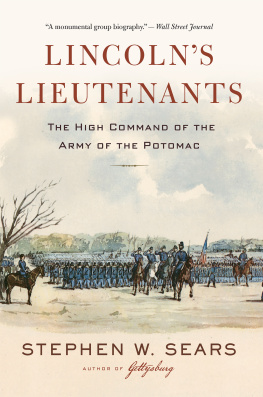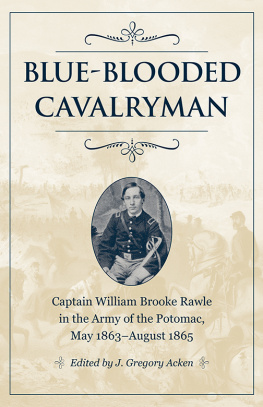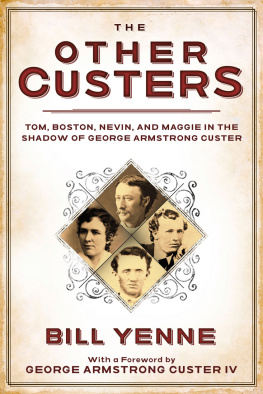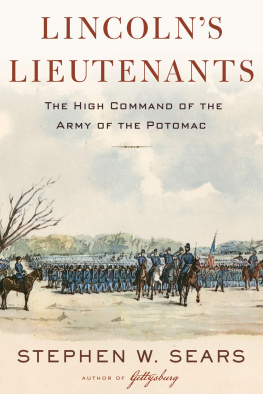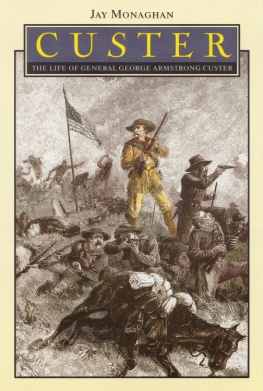T HE B OY G ENERALS
George Custer, Wesley Merritt, and the Cavalry of the Army of the Potomac
Adolfo Ovies
2021 Adolfo Ovies
All rights reserved. No part of this publication may be reproduced, stored in a retrieval system, or transmitted, in any form or by any means, electronic, mechanical, photocopying, recording, or otherwise, without the prior written permission of the publisher.
Library of Congress Cataloging-in-Publication Data
Names: Ovies, Adolfo, author.
Title: The Boy Generals: George Custer, Wesley Merritt, and the Cavalry of the Army of the Potomac / by Adolfo Ovies.
Other titles: George Custer, Wesley Merritt, and the Cavalry of the Army of the Potomac
Description: El Dorado Hills, CA : Savas Beatie LLC, [2020] | Includes bibliographical references and index. | Summary: The first installment in a remarkable trilogy that examines the strategy, tactics, and relationships of the leading Union armys mounted arm and its influence on the course of the Civil War in the Eastern Theater. This volume is a rich and satisfying study that exposes the depths of one of the most dysfunctional and influential relationships in the Army of the Potomac, and its long-lasting impact. Provided by publisher.
Identifiers: LCCN 2020039841 | ISBN 9781611215359 (hardcover) | ISBN 9781611215366 (ebook)
Subjects: LCSH: United States. Army of the Potomac. Cavalry CorpsHistory. | Custer, George A. (George Armstrong), 1839-1876. | Merritt, Wesley, 1834-1910. | United StatesHistoryCivil War, 1861-1865Cavalry operations. | United States. ArmyCavalryHistoryCivil War 1861-1865. | GeneralsUnited StatesBiography. United States. ArmyBiography.
Classification: LCC E470.2.093 2020 | DDC 355.0092/2 [B]dc23
LC record available at https://lccn.loc.gov/2020039841
First Edition, First Printing
Savas Beatie
989 Governor Drive, Suite 102 El Dorado Hills, CA 95762
916-941-6896 / sales@savasbeatie.com / www.savasbeatie.com
All of our titles are available at special discount rates for bulk purchases in the United States. Contact us for information.
Proudly published, printed, and warehoused in the United States of America.
God bless the Irish!
There is no doubt in my mind that my wife, Juliet Ovies Sullivan, would have shouldered her musket and stood in the firing line with the greatest of that warrior race. Faugh a Ballagh! This was the motto inscribed on the regimental flags of the Irish Brigade, and is translated as Clear the Way! She not only cleared the way for this work, but for the course of my life.
I owe her everything.
List of Maps
The Peninsula Campaign: Maj. Gen. George B. McClellans Advance on Richmond, April-May 1862
The Peninsula Campaign: McClellans Change of Base to the James River, May-July 1862
The Battle of Brandy Station: Brig. Gen. John Bufords Cavalry Division on the Right Flank, June 9, 1863
The Cavalry Battles of Aldie, Middleburg, and Upperville, June 17-21, 1863 181 The Armies Move Toward Gettysburg, June 30-July 3, 1863
The Battle of East Cavalry Field, July 3, 1863: The Early Phase of Dismounted Action, 9:00 a.m. - 2:00 p.m.
The Battle of South Cavalry Field, July 3, 1863: Brig. Gen. Wesley Merritts Brigade Goes Into Action
The Battle of East Cavalry Field, July 3, 1863: The Final Phase of Mounted Action, 3:00 p.m. - 5:00 p.m.
Photographs and illustrations have been distributed throughout the book for the convenience of the reader.
F OREWORD
The Hussar and the Dragoon
S TUDENTS OF NAPOLEONIC CAVALRY operations know the French armies of the early nineteenth century featured three types of mounted soldiers: heavy cavalry, which contained armored horses and men (a paradigm never adopted in the United States), dragoons, and hussars. Dragoons were trained to fight equally effectively mounted and dismounted. Hussars were that eras fighter pilots: devil-may-care warriors riding into battle with a saber in one hand and a pretty girl in the other. Dragoons were stodgy; Hussars were flamboyant. There was an obvious fundamental tension between these two different philosophies of how to conduct mounted operations.
This tension carried over into nineteenth-century American military doctrine. The antebellum United States Army also featured three types of mounted units: two regiments of dragoons, a regiment of mounted infantry, and two regiments of light cavalry. The dragoons were much as they had always been: trained to fight equally effectively whether mounted and dismounted. Mounted infantry used their horses to move from place to place and then dismounted to use infantry weapons and infantry tactics. Light cavalry typically carried only sabers and pistols. It was not designed to fight dismounted. Rather, its primary purpose was to perform the traditional role of cavalry: scouting, screening, and reconnaissance. In short, the light cavalry served as the eyes and ears of the army, a more modern incarnation of the hussars of the Napoleonic era.
Advances in technology, however, soon made these artificial distinctions obsolete. The introduction and widespread use of rifled muskets and breech loading carbines meant that there was little need for hussars in a United States military largely designed and trained to fight Native Americans. With the coming of civil war in 1861, the powers in charge of the U.S. Army realized this fact, and did away with the distinctions between dragoons, mounted infantry, and light cavalry, re-designating them with the catch-all name of cavalry. All of these Regular cavalrymen had been trained to act as dragoonsthat is, they could fight effectively mounted or dismounted, and they had been taught how to scout, screen, and reconnoiter, critical roles traditionally reserved for light cavalry. In short, all mounted soldiers serving in the U. S. Army were to become its eyes and ears, not just the light cavalry. The units were re-designated in the order of their seniority: the 1st Dragoons became the 1st Cavalry; the 2nd Dragoons became the 2nd Cavalry; the Regiment of Mounted Rifles became the 3rd Cavalry; and the 1st Cavalrya light cavalry regimentbecame the 4th Cavalry. The 2nd Cavalry, a veritable all-star team of antebellum officers who later achieved prominence during the Civil War (including, but not limited to, Albert Sidney Johnston, Robert E. Lee, John Sedgwick, and John Bell Hood), became the 5th Cavalry. A new unit of light cavalry authorized and raised in 1861, and originally known as the 3rd Cavalry, was soon re-designated as the 6th Cavalry.
As the Army set about the grim task of putting down the rebellion of the Southern states, it did so with a newly unified command of mounted soldiers led by the so-called Father of the U.S. Cavalry, Brig. Gen. Philip St. George Cooke, a stuffy old Regular who had led the 2nd Dragoons for years before the Civil War. Though he was a career dragoon, Cookes tactics reflected those of a hussar and not a dragoon. He quickly discovered that the new era of mounted operations had passed him by.




